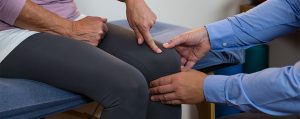So Your Baseball Season is Done….Now What?
If you know anything about youth baseball, the season seems never ending as kids go from one team to another and never seem to have an offseason. Most youth baseball players and parents don’t realize that the offseason is equally if not more important than the regular season. It is a chance for the body to recover and adapt to the changes that were imposed on it during the regular season. Now the offseason does not mean it’s time to sit around and do nothing; it’s a great chance to improve your strength and conditioning and address asymmetries as well as faults in your throwing motion.
The Basics: Sprains, Strains, and Fractures…What’s The Difference?
“I sprained my hamstring!” “I didn’t break it. I fractured it.” “He had a bad ankle strain.” Physical therapists, occupational therapists, and most medical professionals cringe when we hear this at parties, in the media, or our clinic. The tactful among us do their best to resist the urge to correct, but let’s face it, we are only human.
Return to Sport vs. Return to Work
The American Physical Therapy Association describes Physical Therapists as “movement experts who improve quality of life through prescribed exercise, hands-on care, and patient education.” As physical therapists, with our patient’s help, we shape their goals around what improves their specific quality of life. Often, we picture athletes returning to sports or patients relearning how to walk. Less commonly, we think about the importance of injured workers returning to their jobs without limitations. It’s easy to understand why the rehabilitation process for return to sport is so intense and personalized for a patient. The rehabilitation process for return to work should be just as intense and personalized to assist the employee in reaching their goals.
Top Areas to Foam Roll for Gymnasts
Warm-up and recovery are important parts of a workout routine that often get overlooked. A dynamic warm-up prepares the body prior to exercise; conversely, recovery or cooling down after exercise can help manage soreness. Active recovery is a great option to help manage normal muscle soreness symptoms after high-intensity workouts. It is normal to have muscle soreness after high- intensity exercise; this can last for several hours up to several days. Active recovery may help reduce muscle soreness and fatigue.
Why Is There Swelling After an Injury?
Most of us have had an instance where we stepped funny and twisted our ankle or knee, maybe stretched our shoulder too far, or tripped and injured our wrist. These are examples of an acute injury. Acute injuries are usually the result of a single traumatic event. This is in contrast to a chronic injury that occurs with repetition and over time. Swelling is a common occurrence after injury. Swelling is a normal reaction to injury; however, the swelling reaction is excessive sometimes. Let’s look at what happens when your body has swelling after an injury.
Sever’s Disease in Gymnasts
Many young kids that participate in sports can have complaints of pain in their heels. This is more common in children who are actively growing and those who are very active in running and jumping sports. Young gymnasts fall into this category, and they also practice and compete barefoot, which can lead to a higher risk of injury to the foot.
Top Injuries in Male Gymnasts
Male and female gymnasts compete in similar but different events. Men’s gymnastics events place different demands on the body, especially the upper body, for events such as rings, high bar, parallel bars, and pommel horse. Therefore, the top injuries for male and female gymnasts may be different. Current research has shown that adolescent male gymnasts tend to have more lower-body injuries, whereas elite male gymnasts have more upper-body injuries. In general, male gymnasts tend to have more upper body injuries than female gymnasts.
Common Spring Sports Overuse Injuries in High School Athletes
Contrary to what the snow on the ground has told you, spring sports are ramping up at the high school level across the states. And we all know what that means- beginning of season aches and pains. I’ll let you in on a little secret, we athletic trainers see a lot of the same injuries year after year at this time.
In the first few weeks of spring sports, there is a rise in visitors to the Athletic Training Room for overuse injuries. Let’s dig into some of the most common overuse injuries we see in spring and ways to prevent or manage them.

